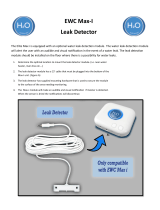
1100-2290 Revision 0
12
MGS-410 Quick Start Guide
8b. Zero Adjustment
WARNING: Except for CO2 or O2 sensors, ambient air may be used instead
of zero gas if the area is know to be free of the target gas or any gases to
which the sensor may be cross-sensitive.
3. Beginzeroadjustment:
MGS-400 App: Home Tab Calibrate scan barcode on gas cylinder or
manually enter values for zero gas.
Manual: hold MAG#1 for >5-seconds. The LED will blink green-green-red when
the instrument is ready.
4. Apply zero gas (or ambient air per warning above).
5. Conrmthestartofcalibration:
MGS-400 App: press the Start Zero button.
Manual: tap MAG#1 within 30-seconds or the instrument will time-out and return
to normal operation.
6. Completezeroadjustment:
MGS-400 App: app will countdown to completion. If calibration is successful,
proceed to Step 12.
Manual: the LED will blink green-red, green-red-red, green-red-red-red,
etc. until calibration is complete. To abort, hold MAG#1 for >5-seconds, turn
off gas flow and remove the calibration adapter. If calibration is successful
(green LED), proceed to Step 12. If calibration is unsuccessful (LED blinks
orange @ 2 Hz), tap MAG#1 to discard the calibration attempt and see the
MGS-400 User Manual (P/N 1100-2294) for troubleshooting.
7. Turnogasowfromzerogas.
8. Replacezerogaswithcalibrationgasinpreparationforspanadjustment.
9. Beginspanadjustment:
MGS-400 App: scan barcode on gas cylinder or manually enter values for
calibration gas.
Manual: hold MAG#2 for >5-seconds. The LED will blink green-green-orange
when the instrument is ready.
10. Apply calibration gas at the concentration listed on the cal gas concentration
label (located on top of the instrument).
8c. Span Adjustment















